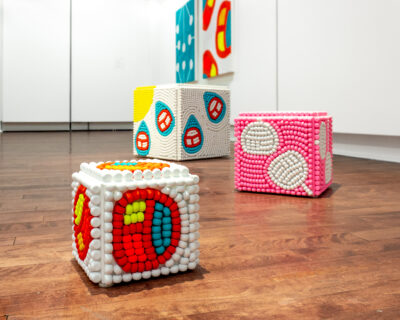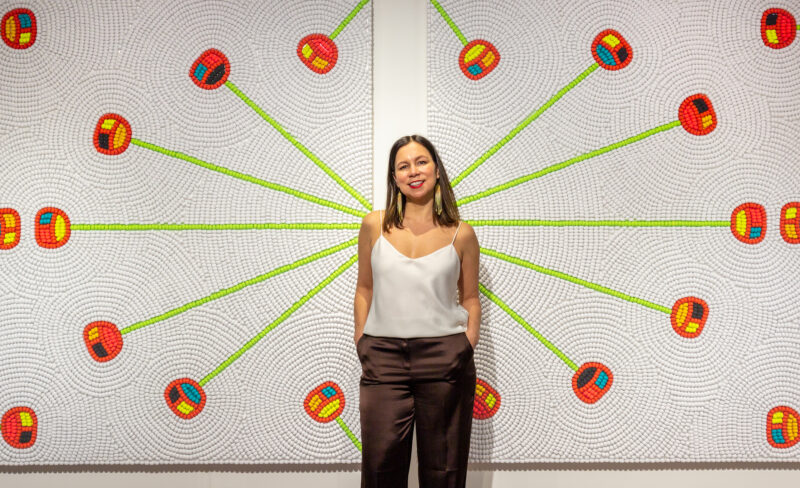Students interview visual artist Renee Condo
This week, Dawson College became one of the few places in Canada to host an exhibition by a nominee of the prestigious Sobey Art Award. Renee Condo is a visual artist of Mi’gmaw descent, hailing from the community of Gesgapegiag, Québec. Shifting Perspectives features her artwork constructed from wooden beads at the Warren G. Flowers Art Gallery until May 6.
On a recent Tuesday afternoon, two visual arts students, Ella Gauthier and Alessandro Ruvo, had the opportunity to ask Condo a few questions.
EG: How do you choose your colour combinations? Is it an intuitive process, picking what you’re drawn to artistically, or do the colours come from specific aspects of your culture?
RC: Looking back at what I was doing in my BFA, I gravitated towards warm and bright colours—like reds and oranges, even in portraiture. I feel these colours are uplifting and I like my work to uplift, but also intuitively I am drawn to them. In earlier abstract works I used fluorescent, bright colours that seem to glow, to be alive. With my thesis work, the colours I used are from the Mi’gmaq creation story—they were brought to the world through the mother. I also like to use colours and colour combinations that might be recognizable or meaningful for other Indigenous people.
AR: Where do you think you would like to take your next project? Do you see yourself continuing to expand on this way of the bead which you have described as having limitless potential? Or are there new horizons for the visual language you want to use?
RC: I will continue to explore this medium and these shapes. I see it as something that is going to be a long-term journey, but I recognize that it is also already changing. For example, the piece I presented at the Plural art fair this weekend was a more figurative, floral design, inspired by a bag beaded by an artist once known from the Nez Perce nation in the late nineteenth century. This beadwork caught my eye from the book The Floral Journey and had a big influence on the abstract motif that I use in the Mntu (pronounced ‘min-du’) series and throughout my work. I have also started to work with more volume, expanding on the cube sculptures here in the gallery. I can see myself changing for decades, as I see myself working for decades.
EG: Your process is very planned. Are there moments when your plan doesn’t work out for your piece? And how do you overcome this?
RC: I have teams of around 10 assistants for some of the larger works, so I don’t always have the time or ability to catch or control everything. I leave space and time to think through the process, but you know there will always be moments or spaces of imperfection—and often when I look at the work, I end up really liking these imperfections. It’s always about finding a balance between being in control and relinquishing control.
AR: How has your previous work, in the arts or not, affected your work today?
RC: When I was a student, I would usually have an idea in my head, and start sourcing materials. I can envision the result sometimes right before the work is made or the night before. I used to work much more intuitively; now I need to be more regimented. Most pieces now take a lot of preparation and planning. Working with these beads, they are individually sanded, then coated up to 7 times, and I must complete the underpainting for the final piece which acts as a blueprint for my team. Yet I can never be fully in control over the execution, even with the best planning.
EG: Are there different mediums you’d like to or have explored, such as beading, painting, or cross-stitching?
This medium I’ve developed is like a baby – so new for me still! So, it’s hard to imagine already moving away from it and working in a new way. Through all my experimentations and work at university as an art student, whatever the medium, it has always been about interconnection. And now that I am using the bead, or bead as symbol, it’s an ideal fit.
I love the rich and multifaceted history of the bead and beadwork. Though my work is not actual beading, there is a tangible connection to its spirit, and it is powerful to see how people relate to this energy.
AR: How do you see the future for Indigenous artists in Canada?
RC: There is a strong interest in Indigenous art right now, with many brilliant Indigenous artists making powerful work. Art is a great way for people to engage in topics that are historic and current, and to be able to see through different perspectives. I hope this continues.
EG: When creating a piece, do you have any specific way you want to exhibit it as? Considering wall colour, lighting, neighbouring works, or other curatorial considerations)?
RC: When I know I am going to exhibit my work in a gallery or a booth, right away I ask for the floor plan—I like to work with the space. So far, I tend to go with the assumption that the walls will be white. I’ve thought about wall colours, but I haven’t really had the time to integrate this aspect. When it comes to lighting, I trust the expertise and experience of the curator and their team.
EG: You’ve told a story about starting and stopping the rain when you were 12, and once again, more recently. Does this incident affect your work, and do you get inspiration from that experience?
RC: I did a write-up of this story for a past exhibition and placed it on the wall alongside the works that ‘illustrated’ it. For that show, there were no other texts at all. This experience does inform my practice. I have personally experienced this story, but I also still have doubts as to what happened: was it a coincidence, do I believe it as I remember it?
This led to a discussion of the interesting combination of science and spirituality in Renee’s work. As Renee said, it brings people comfort to know and understand the unknowable, but is it possible to prove everything? Do we need to have evidence or all the answers? Surrounded by her bright and lively artwork, the interview ended, leaving these deeper questions open for exploration.
By Ella Gauthier and Alessandro Ruvo, April 24, 2023

Renee Condo, The Flavours of Shapeshifting, 2013. Photo by Sylvia Trotter Ewens



